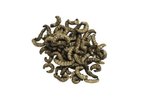The life span of a tapeworm varies based on several factors, but generally, given the opportunity, these pesky parasites are capable of living several years, which are mostly spent stealing nutrients from your pet. As much as this sounds like bad news, the good news is that the tapeworm's life span can be shortened once you recognize its presence and take appropriate action. Poking your nose into the private affairs of a tapeworm reveals important information that'll make you a knowledgeable advocate for your pet's health.
Birth of a Tapeworm
The most common type of tapeworm affecting dogs and cats in North America goes by the scientific name of Dipylidium caninum, explains Susan Little, a veterinarian specializing in parasitology and working for The Center for Veterinary Health Sciences at Oklahoma State University in Stillwater, Oklahoma. The life cycle begins when a tapeworm, living in the dog's or cat's small intestines, sheds several segments containing large numbers of microscopic eggs that are released in the environment either by crawling out of a pet's rectum or being passed along with the pet's feces. Once released in the environment, these segments release eggs, which are consumed by flea larvae, the tapeworm's intermediate hosts.
Tips
Tapeworm segments are visible to the naked eye and look like grains of white rice or sesame seeds. They may be seen temporarily wriggling around your pet's stools or over your pet's fur under the tail, but eventually become immobile as they dry up. If you notice tapeworm segments, bring a sample of the segments to your vet so your pet can be put on an effective tapeworm dewormer.
Infesting Cats and Dogs
Once the flea larvae develop into adults, all it takes for a dog or cat to get infested with them, is to ingest the infected flea by grooming himself. Once inside the pet's body, the flea is digested but the tapeworm survives and establishes itself in the dog's small intestine where it attaches and matures into an adult. Once established, within only two to three weeks, the tapeworm is already capable of releasing tapeworm segments containing eggs, allowing the
The Tapeworm Life Span
One they're residing in your pet's small intestine, tapeworms thrive by robbing your pet of nutrients absorbed through the tapeworm's skin. Left undisturbed, tapeworms may grow more than 6 feet long and can infect pets for a year or more. The life span though can be considerably shortened by using effective products meant to kill these pesky parasites. Take preventive measures to avoid further reinfestation by making the pet's environment less "tapeworm friendly."
Shortening the Life Span
If your pet is infested with tapeworms, it takes a special dewormer to kill them. Your vet likely will prescribe a dewormer containing the active ingredient praziquantel at a dosage based on your pet's body weight. A second treatment may be necessary as you work to eradicate the flea population. Most over-the-counter dewormers for pets do not contain this active ingredient and are therefore ineffective against tapeworms. Another important, and often overlooked, step is to reduce the flea population by using effective products to eradicate them. Where there are fleas, there are opportunities for tapeworms to live, reproduce and thrive if no measures are taken.
References
Writer Bio
Adrienne Farricelli has been writing for magazines, books and online publications since 2005. She specializes in canine topics, previously working for the American Animal Hospital Association and receiving certification from the Certification Council for Professional Dog Trainers. Her articles have appeared in "USA Today," "The APDT Chronicle of the Dog" and "Every Dog Magazine." She also contributed a chapter in the book " Puppy Socialization - An Insider's Guide to Dog Behavioral Fitness" by Caryl Wolff.




